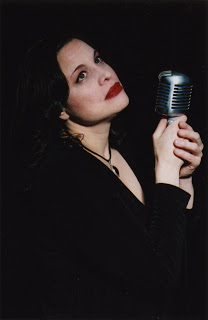La Luna Nueva — Miracle Theatre Group’s festival of Hispanic arts and culture from around the world in celebration of Hispanic Heritage Month — opens in just a couple of weeks, and we couldn’t be more excited about the diverse line-up (see the whole schedule in English; vea el horario completo en español). Our Marketing Assistant Stefanus Gunawan continues his look backstage with an interview with Alma Villegas of “Alma y Azúcar”, musicians from Seattle who will be coming to Portland to share their love of the music of Celia Cruz Sept. 22. Disfrute and relax to the rhythmic latin music of Alma y Azúcar!
First of all, I wanted to thank you for performing and singing at Miracle Theatre in our fourth annual “La Luna Nueva”. How did you start your career in the music industry?
I have always been a performer in some way or another. In fact, my first theatre experience was playing a priest in El diluvio que viene in junior high school at an all-girl catholic school in Tijuana, Mexico.
During my time at San Diego State University, where I received a theatre degree, I didn’t really do any musicals as I was more focused on being a “dramatic” actress; the Greek tragedies were my favorite. After all, these characters had very tragic lives, and being able to express that anguish on a stage was incredibly powerful to me.
In 1992, I moved to Seattle and became very involved with the theatre scene doing a wide range of works including playing a possessed nun in The Devils, the serpent goddess Quetzalcoatl in Memento Mori as well as playing granny in a modern musical version of Little Red Riding Hood called Hood. I also performed with the now long gone Group Theatre in the holiday show Voice of Christmas. It was at The Group that I met Olga Sanchez, when she directed me and a team of very powerful Latina actresses in a stage reading of The House of Bernarda Alba.
In 1999, after seeing several of my beloved theatres shut down due to lack of funding, I decided to take a break from the theatre scene. Then one day at a coffee shop in North Seattle, I saw a young man reading sheet music at his table. I approached him, started a conversation and to make a long story short, he told me about a new salsa band in Seattle that was being formed which, at that time, was looking for a female singer. I had never sang salsa in my life but figured what the hell, I’d give it a try. I went into the audition and sang the classic Mexican bolero Bésame mucho. Immediately, I was hired on the spot.
After a year and a half of performing with the all salsa band Cambalache, I decided that my passion truly lied in the desire to bring the variety of Latin styles to the forefront — when people described Latin music everything was always being placed in the ‘salsa’ category — and form a band that embodied that variety. Soon enough, I decided to form my own band starting with a trio of piano, bass and vocals and focusing on Mexican Boleros, Bossa Novas, Cha Chas and some Cuban rhythms.
Through the years, I added more instruments, recorded my first CD in 2006, my second in 2010 and have been performing in the Northwest ever since.
I have to say that La Reina is one of my favorite singers from Latin America. I remember my first introduction of Celia Cruz; it was the famous “La Vida Es un Carnaval.” Could you tell me how has Celia Cruz’s music inspired you, artistically and daily?
Celia Cruz is a legend, not only because of her struggles having to leave her beloved Cuba but she also pursued and protected her passion, her commitment to her music, and her flashy personality will never be replicated. I can never think of Celia without thinking of that blue wig she wore in her later years.
The first Celia Cruz song I ever sang was ‘Antillana”, a homage to the three of Antilles islands of Borinquen (the ancient name for Puerto Rico), Cuba, and Quisquella (Dominican Republic). It is a song of Cuban pride and identity, something that is reflected in many of her musical selections. I’d like to say that it was her life’s struggles that inspired me to start focusing on her music but in all honesty, the reason why I began singing Celia and continued to add songs that she recorded to my repertoire was simply because as a singer with a pretty low alto voice, it was difficult for me to find songs that fit my vocal range as most popular female singers are sopranos.
I absolutely feel blessed because my vocal range perfectly mirrors Celia’s and that, together with the wide combinations of Cuban rhythms that she highlights like Boleros, Cha Chas , Mambos, Son, and Salsa pretty much sealed the deal for me.
After recording your second CD, why did you and the band select to pay special tribute to the Queen of Salsa Music, Celia Cruz?
Our first CD had a few interpretations of Celia on it. When it came time to put together the song list for the second CD, Alma y Azucar, it seemed only fitting to me that we highlighted our strongest numbers which included several Celia interpretations, starting with my all-time favorite “Bemba Colora”.
Because I have always prided myself on being able to separate myself from other local Latin bands and play a wide range of styles, this CD also includes Mexican boleros as well as more modern Latin pop songs like “Oye Como Va” and one of my all-time favorites “Beautiful Maria” from the 1992 film “The Mambo Kings”.
While the CD isn’t composed of all Celia numbers, my repertoire, which I started building in 1999, is about 85% Celia Cruz. Her songs fit my style and dramatic personality.
How has “la Música Cubana” influenced your style of singing?
My experiences with the salsa band and a year stint with a Cuban Charanga band called Yerba Buena in 2002, introduced me to a wide range of Cuban rhythmic styles. Prior to this, I focused on singing mostly Mexican ballads which were very popular in my home; growing up, my mother had a beautiful voice and sang songs by Agustin Lara.
I love Cuban music especially the Cha Chas from the 1930 and 40s which were made popular in the United States after the big Latin explosion in NY. Cuban music contains a lot of historical roots with a large African influence.
It saddens me to know that there are so many incredibly talented Cuban musicians that the world has never had the opportunity to know and listen. I am grateful for people like Celia Cruz who were willing to give up so much of her when forced to leave Cuba and to bring their music not only to the U.S. but to Europe and beyond. The recent announcement that the Cuban airwaves will soon lift a ban on playing Celia’s songs on the local radio is a huge victory.
What do you hope our audience will experience when they hear, see, and listen to your style of music?
Above everything, I want people to have a good time. Sit back, relax, close their eyes and share my passion for this music. I have been very lucky in finding and convincing some of the best Latin and Jazz musicians in Seattle to grace and back me with their amazing musical talent. They are the real artists. They have worked on their craft for many, many years and are committed to this style of music; I am merely the vehicle that interprets the verbal component of the music they create.
I am always encouraging all singers to be grateful to their musicians because without them, we would not be up there performing. I am Alma (the Soul) but they are Azúcar (the sugar, the sweetness of this music). I always put my musicians first, and I wish there were more appreciation out there for their hard work and dedication.
I am excited to perform the best of Celia for the audiences at Teatro Milagro. But I am even more excited for the opportunity to bring these amazingly talented musicians to them. The grace and beauty of the piano montuno, the deep and sultry syncopation of the bass tumbao, the power and memorable dynamics of the trumpet, and the wide range of rhythmic patterns—the foundation of Cuban music—interpreted with incredible gusto by the conguero. My voice is secondary to them. It is my hope that with this performance, we will remind people of some of the most beautiful Latin music ever written and hopefully introduce them to some new ones.
Find out more about Alma and listen to some music selections on her website: http://www.almavillegas.com/index.html
This year’s La Luna Nueva festival is made possible with the support of PGE Foundation, The Oregonian, Oregon Arts Commission, Regional Arts & Culture Council and Work for Art. Festival events occur September 14-29, 2012 at El Centro Milagro, 525 SE Stark Street, Portland, Oregon 97214; a complete schedule is available here. Admission varies; several events are FREE. Purchase tickets at 503-236-7253 or www.milagro.org (follow links for “La Luna Nueva” in right-hand sidebar).




